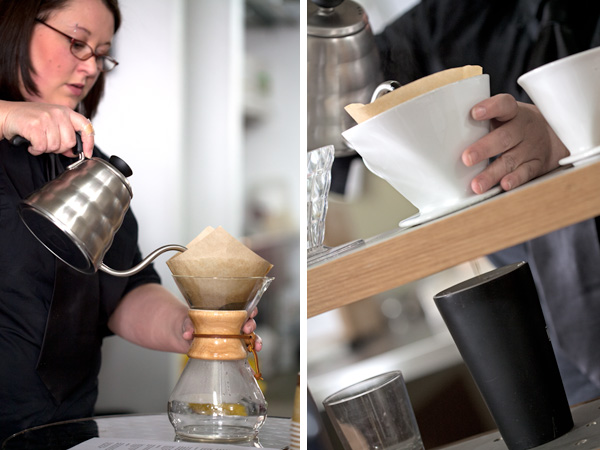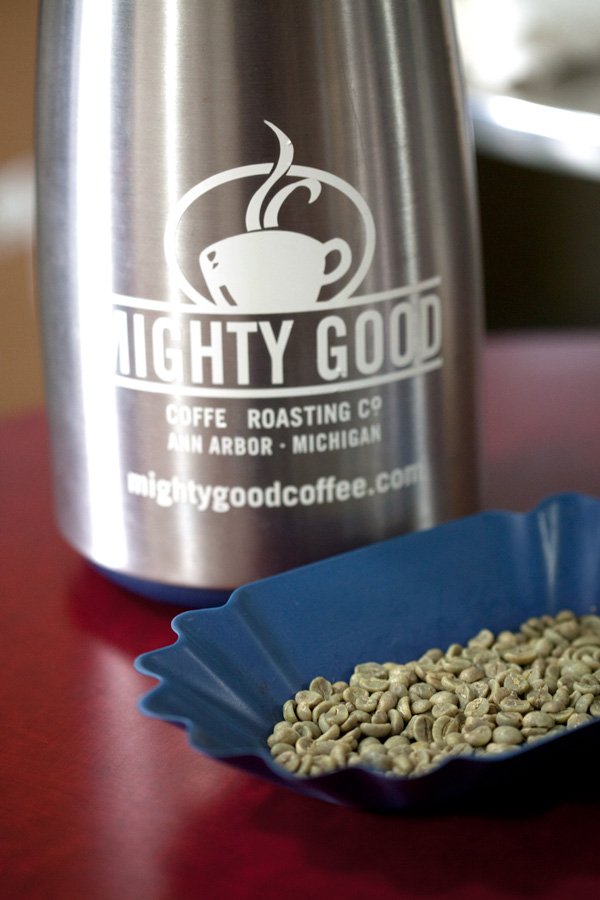
No matter where in the world you live, there are going to be certain things that you cannot get grown locally. The cocoa beans used to make the chocolate we talked about recently is one example. Coffee is another.
Both of us have become shameless coffee snobs over the past few years, to the point that we are currently on our second espresso/cappuccino maker. In the course of learning to make good espresso and coffee drinks, one thing became immediately clear: if you want a good cup of coffee, you simply MUST use good beans. And coffee beans are very temperamental. They become stale within a day or two of grinding and, even after they are roasted, they become stale in just a couple of weeks. This is why, for true coffee lovers, finding a local coffee roaster is essential.
In our area, we are blessed with several coffee roasters. One of them, the Mighty Good Coffee Roasting Company, stands above the others. They work directly with specialty coffee brokers that in turn act as direct traders to growers of high quality beans and they even work directly with some specialty growers themselves. After purchasing extremely high-quality beans, they then roast them in small batches in their Ann Arbor facility ensuring that, even if you buy them from a local grocer, you’re getting coffee that was likely roasted in the past several days. In fact, they only work with local stores that will allow this to happen.
This weekend we attended a class at Mighty Good Coffee that examined several different ways of making coffee. It turns out that, just as there are many different types of coffee from different parts of the world and roasted in different ways, there are also many different ways to make coffee itself. This class focused on manual brewing methods — making coffee without a machine. Using the same bean for all four methods, we learned the best way to make coffee using each process and, more importantly, how different the coffee tastes with each one. The coffee bean we used was Hacienda Rio Negro, a Costa Rican coffee purchased directly from La Minita, a company with 14 separate farms and mills in 3 countries. This coffee was the first Rainforest Alliance-certified coffee in Costa Rica and has only been available for two seasons. The farm has housing for their workers along with medical and dental services right on-site.

The first method we learned about was the Chemex method. This technique was invented by a chemist who wanted to make the best cup of coffee possible each and every time. In this method, the coffee is mixed with hot water — 195-205ºF — in a cone-shaped filter and allowed to drain by gravity into the pot below. The filter is a square sheet of fine-pored filter paper that if folded in half twice then opened into a true cone with a pointed bottom and then prerinsed with hot water to wash it clean and preheat the filter. It is then filled with a medium-coarse grind coffee and some of the water is poured over the grounds. After the coffee “blooms” with the hot water, the remaining water is poured in and the grounds are gently stirred to permit even extraction.
Coffee made with the Chemex method is somewhat less “robust” than with the other methods with a brighter flavor. Since all of the coffee sediments are removed, it has a lighter, even fruity flavor
The second method is similar to the Chemex method and is called the “Pour Over”. Here, too, a cone-shaped filter is used but this time it’s not a true cone with a pointed tip. Rather, the bottom of the cone is flat and the filter paper itself is has larger pores. If you have ever used a Melitta coffee cone, you have used the Pour Over method. Here, the coffee is ground to a medium grind but the overall method is the same as the Chemex method. Because a bit more sedimentation gets through, the flavor is more robust and rich. Unlike with the Chemex method, we could detect hints of chocolate in this delicious brew.

Third was the well-known French Press. Like with the other methods, the equipment is prerinsed/preheated with hot water. The coarsely ground coffee is added to the chamber and half of the water is added. It is allowed to soak 1 minute and then stirred. The remaining water is added and then it sits for exactly 4 minutes before plunging. It is plunged down 1 time, slowly. The coffee is thicker and “muddier” with a rich, robust, and earthy flavor. This coffee was notably hotter in temperature than the others.
Finally, we learned about the Aero Press. This was a new one for me. The Aero Press is made by Aerobie, a company that makes about 500 different discs (“Frisbees”) and 1 coffee press. The coffee made in an Aero Press is very concentrated, almost like espresso. The press and fine disc filter is prerinsed/preheated, fine grind coffee is added and then the water. The mixture is stirred for 10 seconds and then plunger is inserted and manually pushed down to force the coffee through the filter. After it is made, it can be diluted with more hot water to make a standard American-style coffee or with hot milk to make a latte. This is strong coffee with a very rich flavor.
The class was a fascinating look at coffee and how the way we make coffee makes such an immense difference in the flavor and consistency of the coffee. If you want to know more about Mighty Good Coffee, you can visit their website HERE and their blog HERE.

Some interesting coffee facts:
- After crude oil, coffee is the most-traded commodity item in the world.
- The only place in the USA where coffee is grown is Hawaii and they do not produce enough coffee to supply the country.
- Coffee prices are currently at a 14-year high and have nearly doubled in the past year. A combination of speculation, demand and pour crops in South America due to a fungal infection are all responsible.
- Starbucks buys more milk than coffee and they spend more on health insurance for their employees than they do on coffee beans.
- The USA imported over 3 billion pounds of coffee beans in 2010, almost 24 million 60-kilogram bags.
- Americans drink one-fifth of the world’s coffee.
- The earliest accounts of coffee drinking date back to the 15th Century to Sufi monasteries in Yemen.
- An 8-ounce cup of coffee has 60-120 milligrams of caffeine compared to about 20 milligrams for green tea and 45 grams for black tea.